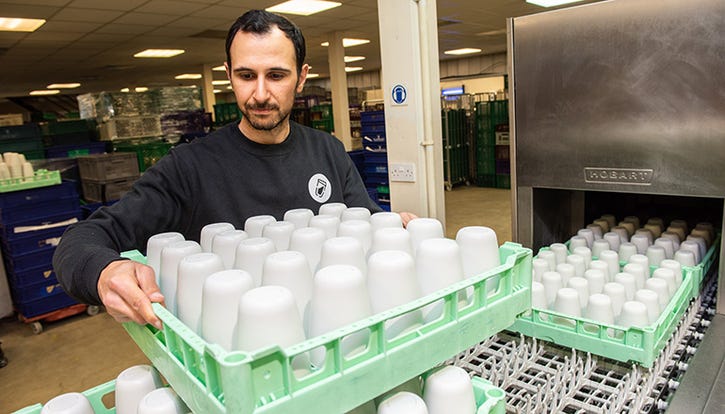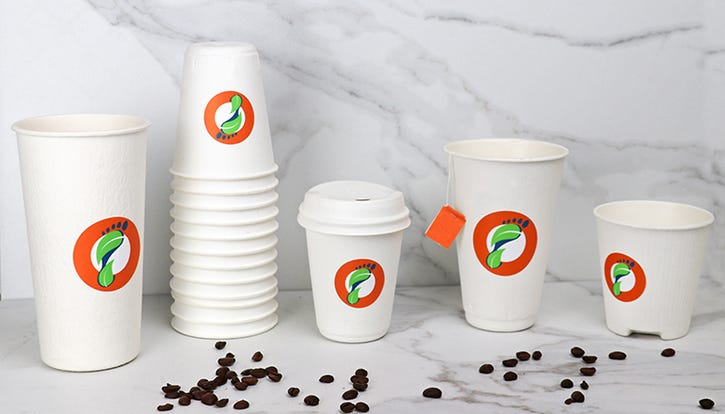Innovators and Closed Loop Partners discuss how they are working to advance more sustainable cup solutions.

Fiber to-go cups have long been recognized as a difficult waste problem. They’re convenient but very hard to recycle due to several challenges, such as polyethene coating. So, at the end of their short lives, these products wind up landfilled, incinerated or in bodies of water.
But some early-stage innovations are springing up to curb this massive fiber waste pileup, and to support their further development, Closed Loop Partners launched the NextGen Cup Challenge. It was a competition to identify 100 percent recyclable, compostable or reusable cup solutions.
Twelve winners were selected and, of those, six entered a business accelerator: Colombier, CupClub, Footprint, Muuse, RECUP and SoluBlue. Waste360 talked to three of those innovators about their products, as well as to Closed Loop Partners about why and how it supports work to advance more sustainable cup solutions.
“The accelerator was a six-month journey in collaboration with our partner [design firm] IDEO that provided participants with feedback and the opportunity to finetune their designs,” says Kate Daly, managing director at Closed Loop Partners, who oversees the NextGen Consortium, a global initiative promoting design and recovery of single-use food packaging.
Accelerator participants did live prototypes at several Google campus cafeterias to demonstrate and observe their products or services in use. They demonstrated how their solutions worked in a materials recovery facility, running tests at Recology’s processing site in the San Francisco Bay area.
Accelerator participant Cambridge, U.K.-based SoluBlue is a material innovation company that created a biodegradable material that looks and feels like plastic but does not have bonds of plastic, which is why it can break down.
Made mainly from seaweed and 100 percent food-grade ingredients, it would last three to four weeks in the ocean and a couple of months on land, according to Joe Tighe, co-founder and managing director of SoluBlue.

The seaweed has other environmental benefits as well. As it grows, it captures carbon dioxide and breaks it down into oxygen, which it releases into the water, supporting marine life. Later, once the cups are composted, the carbon retained by the seaweed is returned to the soil, explains Tighe.
“We use heating and mixing technologies to combine materials into a material that breaks down but with unique properties similar to plastics, such as high tensile strength, so it won’t collapse,” says Tighe.
He has filed for a patent on the ingredients and the methodologies to create SoluBlue. And he is currently in talks with what he describes as several “major food packaging groups” in the U.K. to develop a plant. He plans to next develop a market in the U.S.
Pricing will be key.
“We want to come to a commercial price point that’s not far from plastics and bioplastics. We need enormous scaling potential, and that’s where our focus is now,” he says.
Participant Safia Qureshi, founder and CEO of CupClub, provides a service where reusable cups are delivered, picked up after use, washed and redelivered to corporations and offices with foodservice. Among clients are VISA, real estate services company Cushman & Wakefield and U.K. retailer John Lewis & Partners. The company is working on securing other contracts such as at airports and banks.
The system leverages radiofrequency identification and an Internet of Things connection to scan products, tracking information such as their location and when they were washed, packaged and redelivered, in order to provide a seamless service.
“We are a complete end-to-end, easy to plug-in service, managing all operational requirements. So, our customers do not need to find other partners. They don’t have to procure waste management services or report waste because there is no waste. They just order from us,” says Qureshi.

According to Qureshi, a lifecycle assessment from a third-party sustainability consultant confirmed CupClub’s reusable cups produce half the carbon footprint than single-use products, reducing water and energy consumption and requiring less materials.
The company, which officially launched in 2018, is in a growth stage.
“For now, we are focusing on building out better physical products, optimizing operations and further developing the software platform. We’re adding new cities and different user bases. And there will be different requirements as we scale. We are always looking at the next evolution. So, we have to look at what scale means to us and what’s needed to scale successfully,” she says.
CupClub’s current focus is in North America, and it will start services in three cities in the U.S. and Canada in early 2020.
Gilbert, Ariz.-based Footprint has developed several sustainable manufacturing processes and green material alternatives to single-use plastics. The innovation that earned the company a place in the accelerator is a fiber-based, plastic-free cup that has no seams, which can fail and cause leaks.
The cups are water and oil resistant, further increasing their durability. There are various design versions including one that will allow brands to eliminate the sleeve because it has better thermal properties than current cups.

“We use a manufacturing process that enables us to form the fiber cups in one step and with no seams. And we do the same with the lids. So, we are saving energy and lowering cost while producing a superior cup,” says Jeff Bassett, senior vice president of marketing at Footprint, who says once the product is made at full scale, the cost will be comparative to existing single-use cups.
Footprint is currently pilot testing its product in retail spaces and is looking to market its cups by the end of 2020.
“Once we are in the market, we will be on a steady trajectory of increasing capacity to meet the demand for paper cups that don’t have plastic liners. Forecasting growth at this point is a little challenging, but with over 250 billion plastic-lined paper cups used each year, there is great opportunity for our alternative cup to quickly grow,” says Bassett.
About the Author(s)
You May Also Like




